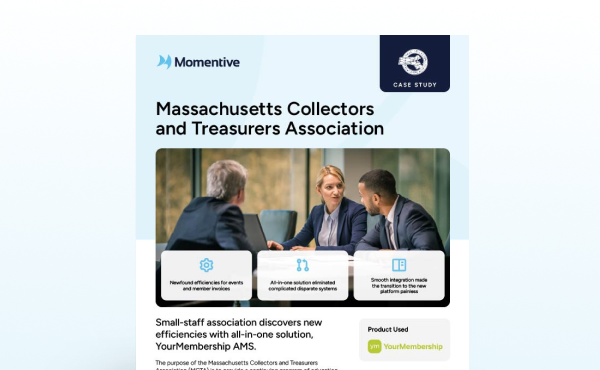Even with a small staff, your association collects a lot of valuable member data.
Here’s what putting that data to work can do to help your organization grow and thrive.
By Caitlin Hustrulid, Marketing Manager, Momentive Software
Data might seem boring to you. But, I challenge you to think about it differently. (Stay with me here – it will be worth it!)
Even as an association with a small staff, you collect a lot of member data. That data is a virtual gold mine of valuable insights that can help you make more informed and precise business decisions.
When you think about the possibilities of what you can do with your member data, things start to get pretty exciting. In fact, you might even realize that you can’t afford not to become a data-driven organization.
What data-based decision making can do for your association
Using the right combination of reports and strategies can make your data come alive. It can give your organization new insights into the entire member lifecycle – from recruitment and engagement to retention. Gaining insights from your data can help your organization avoid missteps, spot trends, and find new opportunities for growth. Ultimately, these insights can make it easier to plan programs, make improvements, manage your overall organization, and deliver a better member experience – all based on data, not on intuition and guesses.
Not convinced that it’s worth the effort? Let’s dig a little deeper into the power of becoming a data-driven organization.
Here are three things that putting data to work for your association can help you achieve:
1) Monitor the health of your organization.
How can you know how well your association is doing if you don’t have an accurate and timely picture of how you’re tracking toward goals and objectives? You can’t.
But if you establish key performance indicators (KPIs) for your organization and set them up in dashboards in your association management software (AMS), then you have a quick and easy view – every day – of the KPIs that impact your association’s success. Having this birds’ eye view of key membership management metrics can help you know what’s working and what’s not so you can keep up the successes and adjust your approach to things when needed.
2) Become proactive instead of reactive.
It’s tough to succeed when you’re always reacting to changes in member needs and evolving world situations. But by using data to gain insights into membership trends, your organization can stay in front of challenges and spot opportunities.
For example, set up a membership report that shows overall membership trends (new members, lapsed members, etc.) as well as a breakdown of key membership demographics. And create a marketing report that shows website visits, email open and click-through rates, and online member community engagement.
You can build reports like these for functions across your entire organization. Then, schedule a regular meeting to review the reports and talk about key trends, what the data is telling you, what you might do to improve numbers that are tracking in the wrong direction, and what you can do to take advantage of opportunities that key trends present. With this approach, you’re always a step ahead.
3) Empower your entire team to move beyond guesswork.
Becoming data-driven is all about moving beyond hunches and guesses. It’s about:
- Understanding the power of data to help your organization grow and evolve
- Putting data collection and review strategies in place
- Regularly using insights from data to inform decision-making
And perhaps the most important point here is that it’s not just for one or two people, or one functional area of your organization. Everyone on your team – from executives and managers to your board of directors – can benefit from data insights.
For example, you can create and filter dashboards and reports for each function in your organization to help focus and streamline everyone’s work. This approach makes it much easier to do things like:
- Find new members and engage with existing members
- Improve membership, marketing, events, accounting, and other efforts
- Engage in more focused board discussions and committee meetings
Learn more
Using member data to inform your business decisions makes it easier to manage your overall organization, plan programs, make improvements, and deliver a better member experience.
Find out more about how YourMembership AMS can help you make data-based decision for your association: Explore YourMembership.







